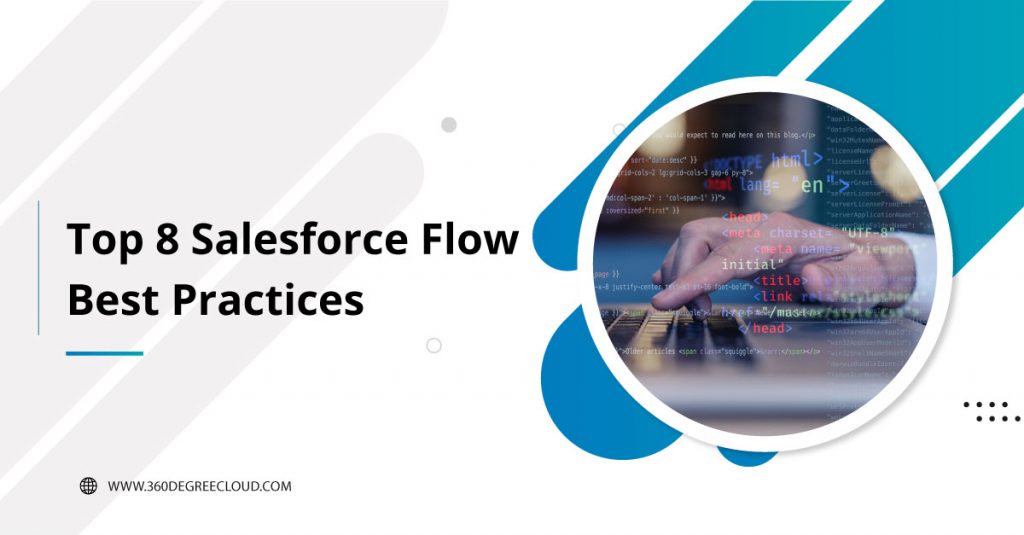Flow is Salesforce’s most powerful automation tool. As Process Builder and Workflow Rules have been retired by Salesforce, it’s essential for every Salesforce app developer to master Salesforce Flow. However, with great power comes great responsibility. Due to its capabilities, it’s important to be careful and adhere to best practices when building flows.
In this blog, we’ll be talking about the best practices that every Salesforce app development company should keep a note of when working with Flow.
Flow Best Practices Every Salesforce App Developer Should Follow
Salesforce Flow has brought an amazing change in the declarative development processes. With the right practices, Flow can be utilized to implement the most powerful automations in Salesforce.
So, the need is to emphasize on the best practices to focus on while using Salesforce Flow.
1. Make Sure to Test Flows
Make sure to thoroughly test your solution before pushing it into production. Flow Builder comes with a built-in debug tool that you can use to test your flows before activation.
This approach helps identify additional issues that may arise during the actual process, which you can then address before deployment. It’s always better to over-test than under-test. Furthermore, Flow Builder now allows the creation and reuse of structured tests, similar to Apex test classes. You can define your expectations and create Flow tests, then run them individually or as a batch.
2. Document Flows
Your Flow will be viewed by other Salesforce Administrators and possibly consultants. To make it easier for them to understand your Flow and its key elements and functions, always create supporting documentation.
A simple yet valuable practice is to ensure each element in your Flow has a meaningful description. This documentation is easily accessible in the Flow Builder and provides immediate clarity. Whether your company hires a new consulting partner for modifications or your internal Salesforce or IT teams grow, this information will be invaluable for maintaining the org.
3. Always Pre-Plan for Faults
Faults and errors are inevitable when working with flows and other automation, so it’s essential to handle them correctly. Ensure your users receive detailed error messages when unexpected actions occur. Planning for and managing faults while working with Flows during Salesforce application development effectively will ensure a smooth and pleasant experience for your end users.
Even after the Flow is live, users may encounter new errors. It’s important to address these issues promptly. By doing so, you can guide users away from repeating actions that lead to errors or provide clear error messages explaining what went wrong, why it happened, and what they should do next.
4. Stay Updated About New Features
Flow is gaining popularity rapidly, and Salesforce keeps enhancing it with every release. Staying updated is crucial as features change frequently.
Take, for example, a common workaround for complex validations using before-save record-triggered flows. Typically, you’d mark a checkbox and trigger a validation rule to show an error message. However, with the Winter ’24 release, Salesforce introduced the Custom Error element. This new feature eliminates the need for a checkbox field and a validation rule for each error message. You can simply use the Custom Error element to display your desired error message.
Additionally, with the Winter ’24 release, you can now use Flow to prevent record deletion, a task previously thought to require Apex code. This update underscores the importance of staying informed about new features to save time, effort, and resources. With the right Salesforce app developer, you can access it efficiently.
5. Never Hard Code Your IDs
]The beauty of Flow lies in its ability to easily retrieve specific information, such as Record IDs or Record Type IDs, without the need for hard coding.
Hard coding IDs is discouraged because they often change when moving between environments. For instance, when developing a new Flow in a sandbox, you test it with sandbox data. If you create a new record type in the sandbox and push it to another environment along with the Flow, the Record Type ID will change when it’s recreated in the new environment.
6. Use Subflows
There can be situations when multiple flows may require the same set of actions. Instead of repeatedly building the same logic, it’s best practice to use subflows. By creating the logic once as an auto-launched or screen flow, you can call it as a subflow whenever those actions are needed. This approach reduces the complexity of your flows, simplifies maintenance, and saves time during Salesforce app development.
7. DML Statements Mustn’t Be Performed in Loops
Avoid performing DML statements inside a loop. This means never doing repetitive Get, Update, Create, or Delete actions (the pink data elements) within a loop. This practice helps significantly reduce the risk of hitting governor limits by controlling the frequency of these data operations.
8. Use Asynchronous Paths and Schedule-Triggered Flow
Schedule-Triggered Flows let you automate actions across records on a regular basis, saving your users time on manual updates. These flows can be scheduled outside of business hours to minimize system impact. However, there are specific considerations to keep in mind when using schedule-triggered flows.
Additionally, to reduce system load, consider creating an asynchronous path in your flows. An asynchronous path queues actions to occur later when the system has more capacity, allowing the initial execution to proceed without delay.
Hire a Salesforce App Developer To Use Flow Efficiently
It’s great that you’re now aware of all essential best practices that should be followed while using Flow. Now, to make it easier, you need to hire a Salesforce developer who understands the importance of these practices and diligently follows them. Contact us and get an experienced and certified Salesforce developer who would make Flow work efficiently for your business.

